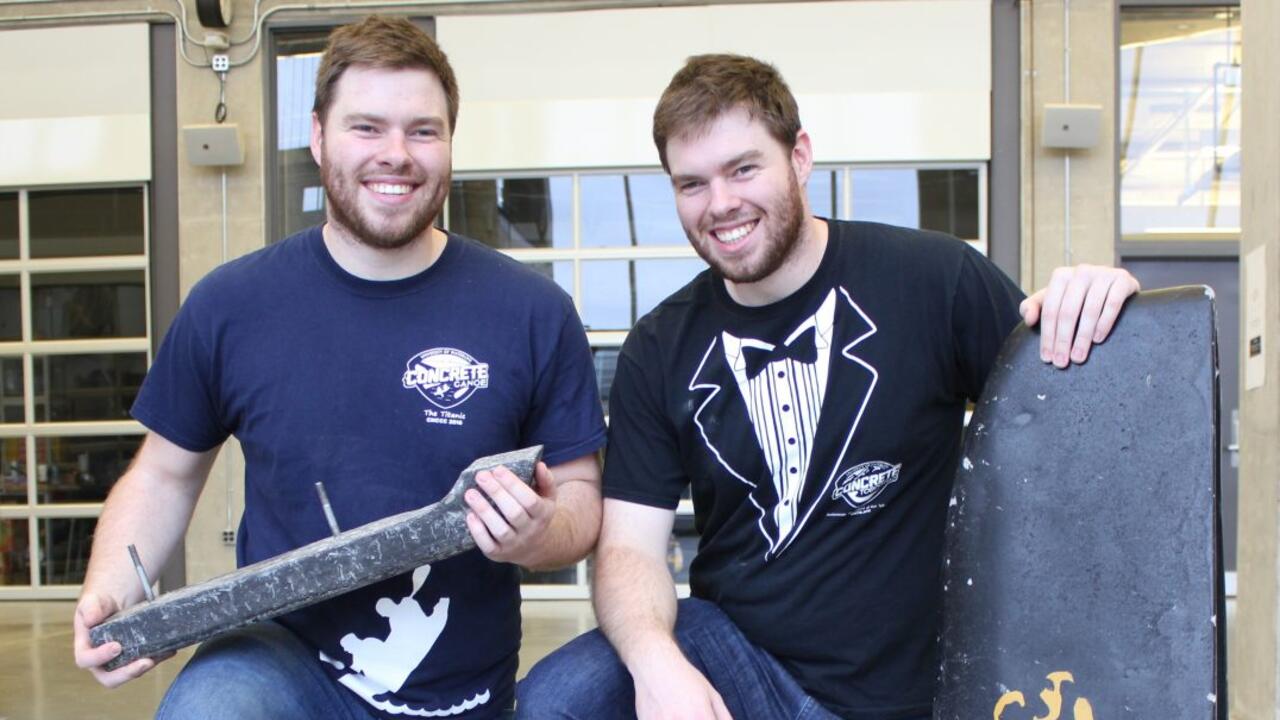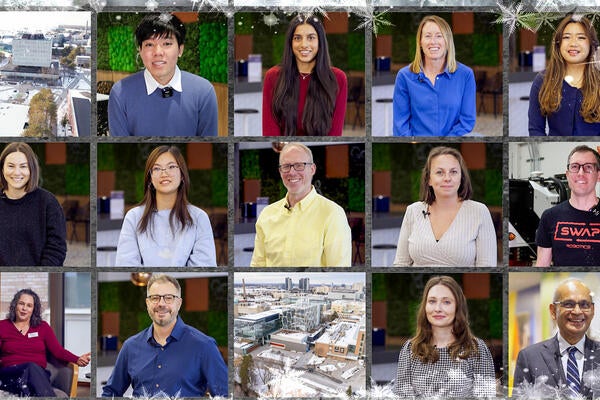
Eyeing the chance to finally go downhill on concrete toboggan
Waterloo Engineering students and twin brothers Russell and Graham Giles are ideal pushers for the Concrete Toboggan team

Waterloo Engineering students and twin brothers Russell and Graham Giles are ideal pushers for the Concrete Toboggan team
By Brian Caldwell Faculty of EngineeringThere is at least one advantage – and a bit of drawback – to being former rugby players and identical twin brothers on a concrete toboggan team.
Size, strength and symmetry make Russell and Graham Giles ideal pushers to get a 300-pound contraption with five helmeted passengers off to a fast, straight start at annual races.
And the drawback?
Their usefulness at the top of the hill means the Cambridge brothers have never actually got to ride in a toboggan with a concrete sliding surface as it hit speeds of up to 50 km/h on the way down.
“We’ve always pushed – every single year,” says Graham.
Still, taking one for the team has done nothing to dampen their enthusiasm for a rather impractical design challenge with history at the University of Waterloo dating back more than three decades.
Both third-year civil engineering students, Russell and Graham joined the toboggan team soon after setting foot on campus, built it up as two of its three captains and helped combine it with a revived concrete canoe squad.
The result is a year-round operation with more than 30 members based out of a bay at the Sedra Student Design Centre. In addition to work, the Concrete Canoe/Toboggan Team has an active social side.
“We live and breathe this stuff,” says Graham. “This is what we spend every free waking hour doing.”
The focus in the winter is on the Great Northern Concrete Toboggan Race, a four-day event in January or February that alternates between eastern and western Canada, and has been going strong for over 40 years.
Entries from university teams can’t exceed 300 pounds, and must slide on concrete skis or rails, hold five riders in a roll cage for safety, be able to turn and have braking systems capable of stopping within a specified distance.
Toboggans were reaching 80 km/h before a broken leg suffered in a crash a few years ago shifted the races to slightly gentler slopes. Wipeouts are still part of the game, however.
“You’ve got to keep your arms and legs inside the ride at all times,” jokes Russell.
The annual Canadian National Concrete Canoe Competition is held in Ontario or Quebec in May. Entries must meet length and width requirements, hold four people and float without tipping over when full of water.
The main design goal is making the canoe’s walls as thin and light as possible by tweaking the three ingredients in concrete – aggregate, water and cement – and materials used to reinforce it.
“Nobody would actually build a canoe out of concrete, but it’s a blast and it’s a challenge,” says Graham, who notes the resulting vessels work surprisingly well.
Although the races are the high-profile payoff for months of work, winners in both events are largely determined by technical presentations and thick reports that accompany entries.
So many former members share memories when current members sell their Boggan Burgers to raise money at alumni events that the team is considering holding concrete canoe races pitting graduation years against each other.
“It’s really fun to hear what the competitions used to be like and how they’ve evolved,” says Russell.
Already firmed up, thanks to the efforts of recent alumni, is that the University will host the national toboggan races at the Chicopee Tube Park in Kitchener in 2018.
While they try to drum up financial support and attract new team members – students from all engineering disciplines, as well as non-engineers, are welcome – the Giles brothers have a personal twist in mind for that event.
“We’re going to be in the toboggan in 2018,” says Russell. “That’ll be our baby.”

Read more
Redefining capstone learning by bringing students, faculty and community partners together to tackle real-world challenges

Read more
Here are the people and events behind some of this year’s most compelling Waterloo stories

Read more
A winter holiday message from President Vivek Goel
The University of Waterloo acknowledges that much of our work takes place on the traditional territory of the Neutral, Anishinaabeg, and Haudenosaunee peoples. Our main campus is situated on the Haldimand Tract, the land granted to the Six Nations that includes six miles on each side of the Grand River. Our active work toward reconciliation takes place across our campuses through research, learning, teaching, and community building, and is co-ordinated within the Office of Indigenous Relations.